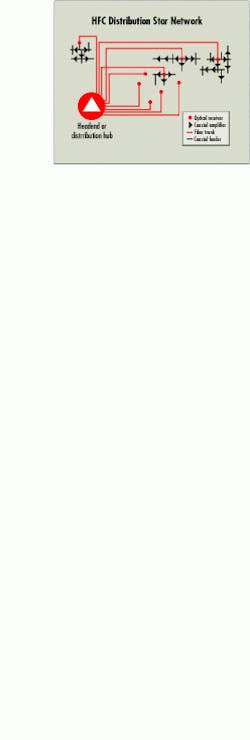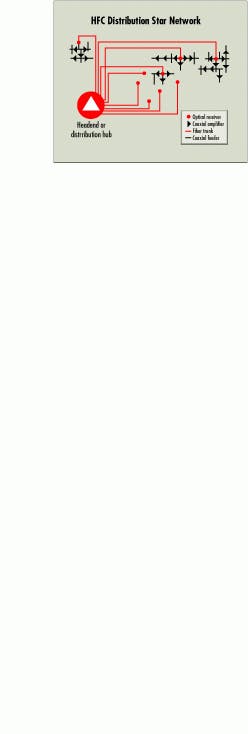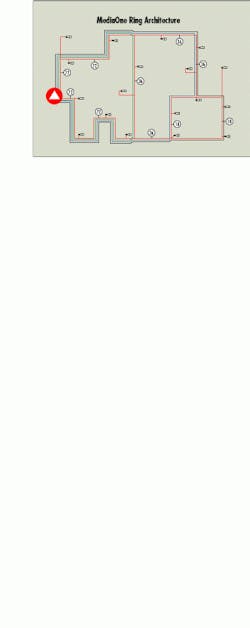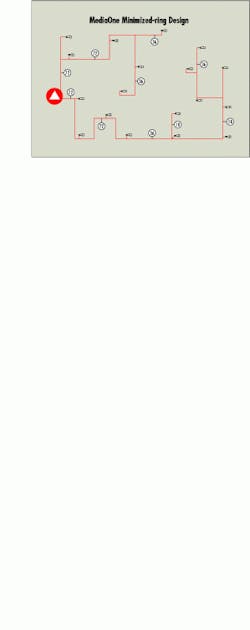A future-minded design
A future-minded design
Is the "minimized ring" a cost-effective hybrid fiber/coaxial cable migration strategy?
Donald T. Gall and Mitch Shapiro
We recently were introduced to an interesting fiber-distribution network-architecture concept coined "minimized ring" by its developer, Randy Midkiff of MediaOne. It allows an elegant incremental path to route diversity and future flexibility without requiring significant additional capital up front. Though the concept is still in the "white paper" stage and as of this writing has not been adopted by MediaOne, we believe it is worthy of industry consideration.
The cable industry has widely adopted route diversity in the fiber transport segment of hybrid fiber/coax (hfc) networks by deploying rings that connect headends to master headends and headends to distribution hubs. The cost of building these rings is distributed across many thousands of homes, which makes the rings relatively inexpensive to deploy on a per-home basis. Employing rings in the distribution portion of the fiber network, however, has been considered by most of the industry too expensive to justify.
The fiber-distribution architecture employed most widely in the industry today is a "star" configuration, in which typically three to six fibers are run by the most efficient route to each optical node. Fiber routes are shared where possible, combining fibers from several nodes into a single sheath (see Fig. 1).
This type of architecture allows adequate future network capability and, if necessary, electronic redundancy (e.g., by adding extra transmitters, receivers, and switches). It also is very cost-effective. Typically, an hfc upgrade design will overlay fiber routes over only 20% to 25% of the existing coaxial network. What this type of design lacks is a cost-effective migration path to the provision of route redundancy.
A star also does not easily allow for the future addition of nodes, if, say, a large new subdivision or apartment complex is built at the outskirts of a fiber-distribution area. In this case, if the operator had not designed additional spare fibers into the network to accommodate this growth, adding a new node could be quite expensive.
To test the minimized-ring concept, the MediaOne staff selected two test areas that totaled 440 plant miles and 64,888 passings at an average density of 146.8 homes passed per mile. They designed both areas using the current star architecture approved by the company. This design supplies six fibers exclusively from the distribution hub or headend to each node. The total project cost for the fiber network was determined, and the statistics were used to benchmark the test.
Next, the same area was redesigned to provide route redundancy by means of a ring architecture. Rings were grouped for timing purposes and efficiency. Two designs were completed. The first had three fibers available to each node from two directions; the second allowed for four fibers each way. The total project cost for both ring designs was determined, and the statistics were used in the overall comparison. Media One`s actual ring architecture is shown in Figure 2.
The minimized-ring design (see Fig. 3) is a subset of the original ring architecture that would allow MediaOne to add the missing ring segments back into the network to achieve route diversity. Until that step is taken, the minimized-ring structure offers all the benefits of a star-based hfc distribution network. It provides four fibers dedicated to each node, which become four in each direction after the full ring is built. The cost savings with the full-ring architecture are realized by removing the most expensive segments in each loop group. The missing segments are then replaced when the service mix, competitive pressures, or other factors call for route redundancy.
In addition to having the same expansion and electronic redundancy capabilities as the star, the minimized ring, when "restored," will incorporate all of the advantages and functionality of the full ring.
The minimized ring groups nodes with similar losses. Similar losses also produce similar delay ranges for the group. Grouping the losses allows the efficient deployment of analog laser transmitters. The similar delays will help when designing a digital fiber overlay to accommodate services such as competitive telephone service using Synchronous Optical Network equipment.
In a star architecture, spare fibers for future growth must be deployed on the correct branch of the star at the time of construction. If an unplanned development "pops up," the network operator may be faced with laying additional cable from the headend or distribution hub. The minimized-ring design eliminates the location aspect of this problem, since spares are available anywhere in the network and can be accessed from any splice point without service interruption.
The MediaOne test comparisons were for the fiber-distribution segments only. The cost estimates for the bill of materials and labor costs are provided in the table. Both System #1 and #2 are actual systems MediaOne has scheduled to upgrade in the near future.
The minimized ring involves roughly $400 more than the star architecture in terms of up-front dollars spent per mile of fiber-optic plant. This amounts to $100 to $140 per total plant mile when folded into the entire project (the cost of the fiber portion of an hfc network usually totals between 25% and 33% of the entire project). The cost of the ring architecture was $600-$1400 more per fiber plant mile than the minimized-ring design. The minimized ring would allow an operator to delay that expenditure until there was a compelling reason to undertake the project. Although the cost ratio stayed the same between the two systems, the lower-density plant cost more per mile to build, which may indicate a sensitivity to density. Since the overall average density of cable-television systems in the United States is approximately 95 homes per mile, this aspect seems worthy of further investigation. uFig 3. The minimized-ring design provides the ability to add ring infrastructure if necessary, while preserving the efficiency of star topologies.



